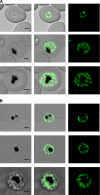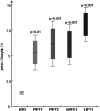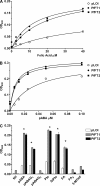The molecular basis of folate salvage in Plasmodium falciparum: characterization of two folate transporters
- PMID: 21998306
- PMCID: PMC3247980
- DOI: 10.1074/jbc.M111.286054
The molecular basis of folate salvage in Plasmodium falciparum: characterization of two folate transporters
Abstract
Tetrahydrofolates are essential cofactors for DNA synthesis and methionine metabolism. Malaria parasites are capable both of synthesizing tetrahydrofolates and precursors de novo and of salvaging them from the environment. The biosynthetic route has been studied in some detail over decades, whereas the molecular mechanisms that underpin the salvage pathway lag behind. Here we identify two functional folate transporters (named PfFT1 and PfFT2) and delineate unexpected substrate preferences of the folate salvage pathway in Plasmodium falciparum. Both proteins are localized in the plasma membrane and internal membranes of the parasite intra-erythrocytic stages. Transport substrates include folic acid, folinic acid, the folate precursor p-amino benzoic acid (pABA), and the human folate catabolite pABAG(n). Intriguingly, the major circulating plasma folate, 5-methyltetrahydrofolate, was a poor substrate for transport via PfFT2 and was not transported by PfFT1. Transport of all folates studied was inhibited by probenecid and methotrexate. Growth rescue in Escherichia coli and antifolate antagonism experiments in P. falciparum indicate that functional salvage of 5-methyltetrahydrofolate is detectable but trivial. In fact pABA was the only effective salvage substrate at normal physiological levels. Because pABA is neither synthesized nor required by the human host, pABA metabolism may offer opportunities for chemotherapeutic intervention.
Figures






Similar articles
-
Genetic and metabolic analysis of folate salvage in the human malaria parasite Plasmodium falciparum.Mol Biochem Parasitol. 2004 May;135(1):77-87. doi: 10.1016/j.molbiopara.2004.01.008. Mol Biochem Parasitol. 2004. PMID: 15287589
-
Transfection studies to explore essential folate metabolism and antifolate drug synergy in the human malaria parasite Plasmodium falciparum.Mol Microbiol. 2004 Mar;51(5):1425-38. doi: 10.1111/j.1365-2958.2003.03915.x. Mol Microbiol. 2004. PMID: 14982635
-
MRP1 mediates folate transport and antifolate sensitivity in Plasmodium falciparum.FEBS Lett. 2016 Feb;590(4):482-92. doi: 10.1002/1873-3468.12079. Epub 2016 Feb 17. FEBS Lett. 2016. PMID: 26900081
-
The folate metabolic network of Falciparum malaria.Mol Biochem Parasitol. 2013 Mar;188(1):51-62. doi: 10.1016/j.molbiopara.2013.02.003. Epub 2013 Feb 27. Mol Biochem Parasitol. 2013. PMID: 23454873 Review.
-
The antifolates: evolution, new agents in the clinic, and how targeting delivery via specific membrane transporters is driving the development of a next generation of folate analogs.Curr Opin Investig Drugs. 2010 Dec;11(12):1409-23. Curr Opin Investig Drugs. 2010. PMID: 21154123 Review.
Cited by
-
Structure and function of Neisseria gonorrhoeae MtrF illuminates a class of antimetabolite efflux pumps.Cell Rep. 2015 Apr 7;11(1):61-70. doi: 10.1016/j.celrep.2015.03.003. Epub 2015 Mar 26. Cell Rep. 2015. PMID: 25818299 Free PMC article.
-
The role of antioxidants treatment on the pathogenesis of malarial infections: a review.Parasitol Res. 2014 Mar;113(3):801-9. doi: 10.1007/s00436-014-3804-1. Epub 2014 Feb 13. Parasitol Res. 2014. PMID: 24525759 Review.
-
Inhibition of p-aminobenzoate and folate syntheses in plants and apicomplexan parasites by natural product rubreserine.J Biol Chem. 2012 Jun 22;287(26):22367-76. doi: 10.1074/jbc.M112.365833. Epub 2012 May 10. J Biol Chem. 2012. PMID: 22577137 Free PMC article.
-
Decreased activity of folate transporters in lipid rafts resulted in reduced hepatic folate uptake in chronic alcoholism in rats.Genes Nutr. 2013 Mar;8(2):209-19. doi: 10.1007/s12263-012-0318-2. Epub 2012 Sep 7. Genes Nutr. 2013. PMID: 22956120 Free PMC article.
-
Roles of the apicoplast across the life cycles of rodent and human malaria parasites.J Eukaryot Microbiol. 2022 Nov;69(6):e12947. doi: 10.1111/jeu.12947. Epub 2022 Sep 30. J Eukaryot Microbiol. 2022. PMID: 36070203 Free PMC article. Review.
References
-
- Fox J. T., Stover P. J. (2008) in Folic Acid and Folates (Litwack G., ed.) pp 1–44, Academic Press, Inc., New York
-
- Gregson A., Plowe C. V. (2005) Pharmacol. Rev. 57, 117–145 - PubMed
-
- Tan-ariya P., Brockelman C. R. (1983) J. Parasitol. 69, 353–359 - PubMed
-
- Tan-ariya P., Brockelman C. R., Menabandhu C. (1987) Am. J. Trop. Med. Hyg. 37, 42–48 - PubMed
Publication types
MeSH terms
Substances
Grants and funding
LinkOut - more resources
Full Text Sources
Medical
Molecular Biology Databases

